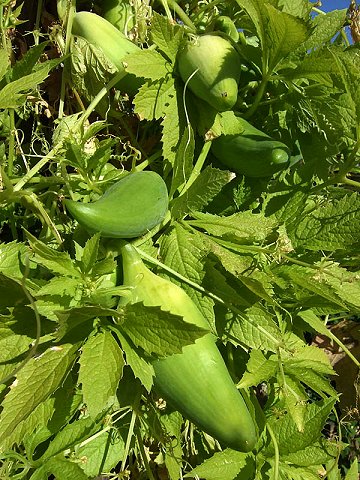
|
|
Achocha/Caigua - Inca cucumber
(Cyclanthera pedata).
Leaves and, fruits.
|
Achocha/Caigua - Inca cucumber - Cyclanthera pedata
Cyclanthera pedata, belongs to the Curcurbitaceae family,
locally known by its Quechua names kaywa (pronounced kai-wa, hispanicized spellings caigua, caihua, caygua, cayua) or achuqcha (also spelled achocha, achogcha, achojcha, achokcha), is a herbaceous vine grown for its edible mature fruit, which is predominantly used as a vegetable. Kaywa is known from cultivation only, and its large fruit size as compared to closely related wild species suggests that it is a fully domesticated crop. Its use goes back many centuries as evidenced by ancient phytomorphic ceramics from Peru depicting the fruits. It is also known as slipper gourd, lady's slipper, sparrow gourd (Chinese pinyin: xiaoque gua), pepino in Colombia, stuffing cucumber in English, korila in the Philippines, and olochoto and kichipoktho in Bhutan. It is also called chuche karela in Nepal and Southern Bhutan.
C. pedata is native to the southamerican Andes, Centralamerica, Mexico and Argentina. Domesticated in the Andes, it spread throughout Colombia and Bolivia in ancient times. It is now grown all across Central and South America, as well as India,
Nepal and Bhutan. The Moche culture had a fascination with agriculture and displayed this in their art. The kaywa was often depicted in their ceramics.
C. pedata is an annual climbing plant but for some reasons it can also be perennial. It reaches a height of about 5 to 6 m. The leaves are palmate and can get 19 to 24 cm big. If one cracks a leaf from the shoot one smells a cucumber like odor. The flowers are small, greenish, white or yellow. The female flowers stand solitary, the male ones in groups.
The fruits is pale green, can get 15 cm long and
3-5 cm wide, and has thin thorns on her surface. They look just like lady slippers, because of that they have this as a nickname, hollow with several black seeds resembling tree bark. The black seeds lay in the white pulp.
The fruits can be eaten. The fruits can be eaten raw and taste just like cucumber. They should be eaten when they have reached a size of about 2 cm. In this stadium there are no seeds in the pulp. Some people do not like the seeds although they are eatable, too.
Sometimes the fruits are nearly empty and can be filled with different stuff for cooking. In Central and South America the fruits are eaten either raw or cooked after removal of the seeds. They are also prepared as stuffed peppers; stuffed with meat, fish or cheese and then baked or fresh. This may have inspired the local Spanish name pepino de rellenar ("stuffing cucumber"). The young shoots and leaves may also be eaten as greens.
The ripe fruit contains phytochemicals such as peptins, galacturonic acid, resins, lipoproteins and various steroidal compounds.Medical studies in Peru have shown that achocha can lower cholesterol levels. In herbal medicine a tea from the seeds is used for controlling high blood pressure. The seeds and/or the fruits are also recommended for gastrointestinal disorders. The leaves are considered hypoglycemic and prepared in a decoction for diabetes. The fruits are boiled in milk and gargled for tonsillitis. The fruit juice is also recommended for high cholesterol, hypertension, tonsillitis, arteriosclerosis, circulatory problems, diabetes and as a diuretic. The fruit and/or the leaves are boiled in olive oil and used externally as a topical anti-inflammatory and analgesic. The roots are used to clean the teeth.
Caigua is said to be one of the last crops of the
Incas. The plant has a natural resistance to both disease and pests and is a heavy
producer.Heat tolerant and productive if they have consistent soil moisture, they will stop producing and go dormant if the soil becomes too dry, resuming flowering and fruiting when moisture returns. They will tolerate some cold, but no frost.
Can be started inside along with tomatoes and transplanted out in shorter season or cool spring areas.
Source:
https://en.wikipedia.org/wiki/Cyclanthera_pedata
http://store.underwoodgardens.com/Achocha_Caihua-Cyclanthera-pedata
http://www.asklepios-seeds.de/gb/cyclanthera-pedata-seeds.html
